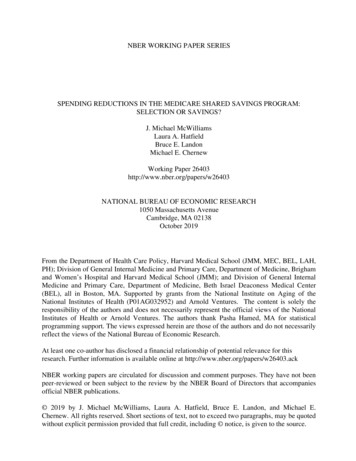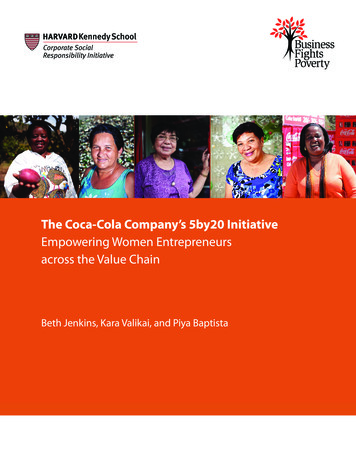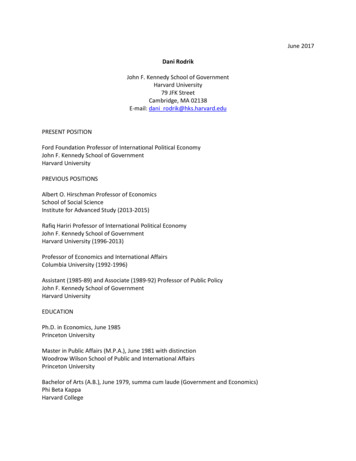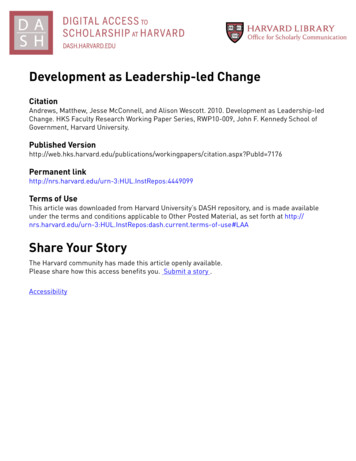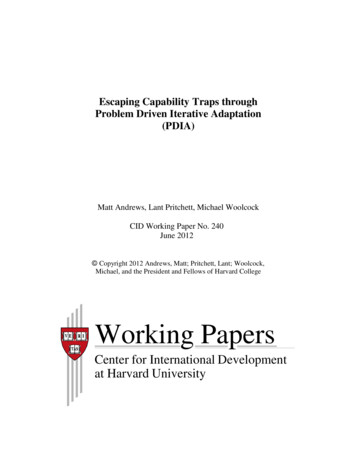
Transcription
Escaping Capability Traps throughProblem Driven Iterative Adaptation(PDIA)Matt Andrews, Lant Pritchett, Michael WoolcockCID Working Paper No. 240June 2012 Copyright 2012 Andrews, Matt; Pritchett, Lant; Woolcock,Michael, and the President and Fellows of Harvard CollegeWorking PapersCenter for International Developmentat Harvard University
Escaping Capability Traps Through ProblemDriven Iterative Adaptation (PDIA)Matt Andrews, Lant Pritchett and Michael Woolcock1June 15, 2012AbstractMany reform initiatives in developing countries fail to achieve sustained improvements inperformance because they are merely isomorphic mimicry—that is, governments andorganizations pretend to reform by changing what policies or organizations look like rather thanwhat they actually do. The flow of development resources and legitimacy without demonstratedimprovements in performance, however, undermines the impetus for effective action to buildstate capability or improve performance. This dynamic facilitates ‗capability traps‘ in which statecapability stagnates, or even deteriorates, over long periods of time despite governmentsremaining engaged in developmental rhetoric and continuing to receive development resources.How can countries escape capability traps? We propose an approach, Problem-Driven IterativeAdaptation (PDIA), based on four core principles, each of which stands in sharp contrast withthe standard approaches. First, PDIA focuses on solving locally nominated and defined problemsin performance (as opposed to transplanting pre-conceived and packaged ―best practice‖solutions). Second, it seeks to create an ‗authorizing environment‘ for decision-making thatencourages ‗positive deviance‘ and experimentation (as opposed to designing projects andprograms and then requiring agents to implement them exactly as designed). Third, it embedsthis experimentation in tight feedback loops that facilitate rapid experiential learning (as opposedto enduring long lag times in learning from ex post ―evaluation‖). Fourth, it actively engagesbroad sets of agents to ensure that reforms are viable, legitimate, relevant and supportable (asopposed to a narrow set of external experts promoting the ―top down‖ diffusion of innovation).1Andrews and Pritchett are with Harvard University‘s Kennedy School of Government; Woolcock is with theDevelopment Research Group, World Bank. The corresponding author is Matt Andrews, Assistant Professor,Harvard Kennedy School, 116 Rubenstein, 79 John F. Kennedy Street, Cambridge, MA, 02138, USA. Emailaddresses for correspondence: matt andrews@hks.harvard.edu, lant pritchett@hks.harvard.edu andmwoolcock@worldbank.org. This paper is part of a broader research agenda at the Harvard Kennedy School‘sCenter for International Development supported by WIDER. The views expressed in this paper are those of theauthors alone, and should not be attributed to the respective organizations with which they are affiliated. Helpfulcomments from participants at various seminars and conferences are gratefully acknowledged.1
IntroductionSome building is easy. Development projects have, by and large, been successful at buildingphysical stuff: schools, highways, irrigation canals, hospitals and even building the buildings thathouse government ministries, courts and agencies. But some building is hard. As anyone withexperience in development knows, building the capabilities of the human systems is hard. Thatapplies to the human system called ―the state.‖ Getting the human beings in the state to use thephysical stuff available to produce the flows of improved services (learning in schools, water tofarmers, cures for patients) that lead to desirable outcomes for citizens has proven much moredifficult.There is no shortage of small and large scale examples. One of us was recently asked toreview the design of an education project in an African country; it was the sixth in a string oflarge projects supporting education in this country. The project documents described thedeplorable state of the capability of the ministry of education to even implement the project—much less to autonomously define problems, gather and analyze information, make decisionsbased on analysis, and implement their own decisions. Therefore the project proposed funding tobuild more schools but also significant funding to build the capability of the ministry. But ofcourse all of the five previous projects over a span of twenty years had also sought to build bothschools and ministry capability, and had succeeded at only one of those objectives.This dynamic also often characterizes ―policy reform‖: a government succeeds in passinglaws or creating new boxes in organizational charts or declaring new administrative processes,but these ―reforms‖ are frequently not implemented or used. Andrews (2011), for example,documents the case of the adoption of public financial management reforms in Africa, showinghow the higher level and surface processes changed (e.g., how budgets were written and newaccounting techniques were adopted) but how the core processes determining how money wasactually spent remained impervious to reform. Perhaps the most spectacular large-scalecontemporary example is that the richest and most powerful nation in the history of humankindhas just spent a decade—and enormous amounts of blood (almost 2000 dead) and treasure (overhalf a trillion dollars)—attempting to (re)build state capability in a very small and poor SouthAsian country. The United States is now committed to leaving by 2014, almost certainly leavingbehind a state less capable than what Afghanistan had in the 1970s.2
Why has building state capability been so hard? In past work we argued that developmentinterventions—projects, policies, programs—create incentives for developing countryorganizations to adopt ‗best practices‘ in laws, policies and organizational practices which lookimpressive (because they appear to comply with professional standards or have been endorsed byinternational experts) but are unlikely to fit into particular developing country contexts.2Adapting from the new institutionalism literature in sociology3, we suggested that reformdynamics are often characterized by ‗isomorphic mimicry‘—the tendency to introduce reformsthat enhance an entity‘s external legitimacy and support, even when they do not demonstrablyimprove performance. These strategies of isomorphic mimicry in individual projects, policiesand programs add up to ‗capability traps‘: a dynamic in which governments constantly adopt―reforms‖ to ensure ongoing flows of external financing and legitimacy yet never actuallyimprove. The fact that the ―development community‖ is five decades into supporting the buildingof state capability and that there has been so little progress in so many places (obviousspectacular successes like South Korea notwithstanding) suggests the generic ―theory of change‖on which development initiatives for building state capability are based is deeply flawed.How might countries escape from capability traps? This is the question we beginanswering in the current article. We first revisit the argument about how and why countriesand development partners get trapped in a cycle of reforms that fail to enhance capability(indeed, may exacerbate pre-existing constraints). We posit that capability traps emergeunder specific conditions which yield interventions that (a) aim to reproduce particularexternal solutions considered ‗best practice‘ in dominant agendas, (b) through predetermined linear processes, (c) that inform tight monitoring of inputs and compliance to‗the plan‘, and (d) are driven from the top down, assuming that implementation largelyhappens by edict.42See Pritchett and Woolcock (2004); Pritchett, Woolcock and Andrews (2010); and Andrews (2011).See the classic work of Dimaggio and Powell (1983).4An important paper by Denizer, Kaufmann and Kraay (2011: 2), however, shows that implementation isactually of crucial importance to project quality. On the basis of an examination of 6000 World Bank projects,these authors conclude that ―measures of project size, the extent of project supervision, and evaluation lags areall significantly correlated with project outcomes, as are early-warning indicators that flag problematic projectsduring the implementation stage measures of World Bank project task manager quality matter significantlyfor the ultimate outcome of projects.‖33
A second section suggests that capability traps can be avoided and overcome by fosteringdifferent types of interventions. In direct counterpoint to the four conditions above, we proposethat efforts to build state capability should (i) aim to solve particular problems in local contexts,(ii) through the creation of an ‗authorizing environment‘ for decision-making that allows‗positive deviation‘ and experimentation, (iii) involving active, ongoing and experiential learningand the iterative feedback of lessons into new solutions, doing so by (iv) engaging broad sets ofagents to ensure that reforms are viable, legitimate and relevant—i.e., politically supportable andpractically implementable. We propose this kind of intervention as an alternative approach toenhancing state capability, one we call Problem Driven Iterative Adaptation (PDIA). Weemphasize that PDIA is not so much ‗new‘ thinking as an attempt at a pragmatic and operationalsynthesis of related arguments articulated in recent years by an array of scholars and practitionersof development working in different sectors and disciplines.I)Capability traps in the effort to build state capabilityDevelopment interventions can be usefully analyzed at three social levels (Figure 1): agents, atthe front line and in leadership positions; organizations inhabited by agents; and the environmentor ecosystem of organizations. Within each category, Figure 1 also illustrates the poles ofbehaviors (for agents and organizations) or conditions (within eco-systems).Frontline workers decide daily between mere compliance with rules (or even negativedeviations) and positive performance-driven actions. Leaders and managers choose betweenusing their positions to pursue narrow private or organizational gain or to create new publicvalue within and through the organizations they run. Organizations manage how and fromwhence they derive the legitimacy needed to survive and thrive, balancing isomorphic pressuresto comply with external expectations of what they should look like and the challenge ofdemonstrating performance regardless of appearance.At the systemic level, fields of organizations that include suppliers, producers, regulators,funders and consumers determine implicit and explicit ways of evaluating change and novelty.Systems could reward compliance with fixed agendas of what is considered appropriate and4
‗right‘ practice at one extreme, or look to the simple demonstration of improved functionality atanother. A second tension also plays out at this systemic level, affecting the space created fornovelty: closed systems constrain novelty and do not allow new approaches to emerge, whileopen systems facilitate novelty (see Brafman and Beckstrom 2006).Figure 1.Tensions playing out at different levels of engagement in developmentSource: Pritchett, Woolcock and Andrews (2010)Countries find themselves in capability traps when conditions at each level fosterdecisions and behaviors on the left side of Figure 1; this can create a low level equilibrium.When the ecosystem for organizations evaluates novelty based on agenda-conformity rather thanenhanced functionality, then the space for novelty is closed and subsequently cascades (Carlileand Lakani 2011). In such situations, organizations adopt ―isomorphic mimicry‖ strategies oflooking like successful organizations: leaders seek organizational survival, continued budgetsand rents by complying with external standards of legitimacy instead of encouraging new ideas,5
products and solutions, while front line workers choose routine compliance (at best; at worst,often corruption or malfeasance) over concern for the customers, clients and citizens they serve.The difficult reality is that once the ―capability trap‖ is sprung there is no incentive—and oftenno possibility—for any one organization or leader or front-line agent to break out.Much of the literature on capacity and corruption focuses on the role agents play in suchsituations. It is common to hear statements like: ―The country would progress if only it had lesscorrupt leaders and more capable and concerned civil servants.‖5 Blaming agents in this waysuggests a personalized rather than systemic perspective on why countries remain poor—onewhich is obviously false. This perspective has yielded efforts to discipline agents and limit theopportunities for rent seeking via organizational interventions like civil service, judicial andpublic finance reform. Organizations in developing countries have been required to accept suchinterventions for decades now. As Rodrik (2008: 100) notes, ―institutional reform promoted bymultilateral organizations such as the World Bank, the International Monetary Fund, or theWorld Trade Organization (WTO) is heavily biased towards a best-practice model. It presumes itis possible to determine a unique set of appropriate institutional arrangements ex ante, and viewsconvergence toward those arrangements as inherently desirable.‖ Such apparent convergence isundertaken to ensure continued legitimacy with, and support from, the international community.A common example is procurement reform: laws requiring competitive bidding are a procedurethat many development organizations require their client countries to adopt in order to receivefinancial support. Such requirements, for instance, were among the first demands internationalorganizations made in post war Liberia, Afghanistan and Sudan. They are intended to constraincorruption, discipline agents, and bring an air of formality and legitimacy to the waygovernments operate.We hold, however, that these reform initiatives are now, ironically, among the drivers ofcapability traps in developing countries, because they create and reinforce processes throughwhich global players constrain local experimentation—while at the same time facilitating the5For example, Greg Mills from South Africa‘s Brenthurst Foundation recently noted that Malawi would be doingbetter ―If only Malawians were luckier with their leaders.‖ See his article in the Malawi ng-fingers-in-the-warm-heart-of-africa/6
perpetuation of dysfunction6. The conditions we allude to have characterized the politics andprocesses of international development since at least the 1980s, a period when governmentreform became an important dimension of development work. At that time, many externaldevelopment organizations began tying their funds to such reforms, as well as using conditionsin structural adjustment and other budget financing initiatives (e.g. ―sector wide‖ approaches).This has made it increasingly difficult for a developing country to receive external financialassistance without committing to change their government and market structures. Thecommitments must be made ex ante and promise reform that is open to visible evaluation inrelatively short time periods, such that external development partners have something tangible topoint to when justifying the disbursement of funds. In this relationship, development partnershave to accept proposed reform ideas and sign off on their attainment. This role has fed thecreation of various scripts defining acceptable types of reform. The World GovernanceIndicators, for instance, guide countries in choosing governance reforms by illustrating what isconsidered legitimate. Similarly, the Doing Business indicators inform what reforms are neededto the institutions connecting government and the private sector, while mechanisms such asPublic Expenditure and Financial Accountability (PEFA) indicators focus developing countrieson conforming with characteristics ostensibly reflecting “good international practices critical to achieve sound public financial management‖ (PEFA 2006: 2).Such scripts, we argue, have essentially closed the space for novelty in the developmentsystem, imposing narrow agendas of what constitutes acceptable change. Developing countriesand organizations operating within them are regularly evaluated on their compliance with thesescripts, and the routine and generalized solutions they offer for establishing ―good governance‖,facilitating private sector growth, managing public finances, and more. Organizations likefinance ministries or central banks gain legitimacy by agreeing to adopt such reforms, regardlessof whether they offer a path towards demonstrated success in a particular context. Leaders of theorganizations, for their part, can further their own careers by signing off on such interventions.Their agreement to adopt externally mandated reforms facilitates the continued flow of external6Our argument at the institutional and organizational level is similar to that made by Nicolas van de Walle(2001) about ―structural adjustment‖ in Africa. He points out that engagement of governments in the process ofreform—even when patently insincere on the part of governments and when reforms were not implemented—brought external legitimacy. This contributed to the puzzle of the region with the worst development outcomeshaving the most stable governments.7
funds, which can further various public and private interests. Front line workers ostensiblyrequired to implement these changes are seldom part of the conversation about change, however,and thus have no incentive to contribute ideas about how things could be improved.The example of procurement reform in countries like Liberia and Afghanistan is a goodinstance of this dynamic in action. PEFA indicators and United Nations models of goodprocurement systems tout competitive bidding as a generic solution to many procurementmaladies, including corruption and value for money concerns. Competitive bidding regimes areintroduced through laws, as are the creation of independent agencies, the implementation ofprocedural rules and the introduction of transparency mechanisms. These various ‗inputs‘ arereadily evaluated as ‗evidence‘ that change is in effect. Countries are rewarded for producingthese inputs; government entities and vendors subjected to such mechanisms are assumed tosimply comply. The result is a top-down approach to building procurement capacity (andbeyond) in these governments, through which external role players impose themselves on localcontexts and crowd out potential contributions local agents might make to change. These localagents have every incentive to treat reforms as signals, adopting external solutions that are notnecessarily politically accepted or practically possible in the local context. But when theconditions are wrong, this mimicry signaling is the easiest route to achieving legitimacy,especially when the pathway to creating real value and facilitating actual improvement inperformance is uncertain, risky and potentially contentious. Local agents have little incentive topursue improved functionality in such settings, especially when they are rewarded sohandsomely for complying with externally mandated ‗forms‘ (appearances).II)Escaping capability traps and actually building state capabilityThe emphasis on form (what organizations ‗look like‘) over function (what they actually ‗do‘) isa crucial characteristic of the capability trap facing many developing countries. The challenge ofescaping this trap therefore involves focusing on improved government functionality as the keyto improved state capability. The basic message must be that interventions are successful if theyempower a constant process through which agents make organizations better performers,8
regardless of the forms adopted to effect such change. The politics of this re-focusingrecommendation are obviously complex. They require, for instance, challenging perspectivesabout when and how to tie development funding to reform results, asking if external agents andsolutions can build local state capabilities, and clarifying whether and how local agents andsolutions should play a greater role in their own development. They may also entail adoptingreforms that, at least initially, powerful critics can deride as unprofessional (‗promoting nonbest-practice solutions‘), inefficient (‗reinventing the wheel‘), even potentially unethical (‗failingto meet global standards‘). These are far from idle concerns.This section does not address these political narratives. Instead, it offers some potentialideas and practical suggestions for how the development process might look if political discoursedid call for a change in the approach to reforming governments and building state capability. Asnoted above, we fully recognize that others have voiced related concerns across various sectorsin a range of forums; these previous articulations, however, have mostly stopped at critiquerather than moving on to propose concrete, supportable, implementable alternatives. To this end,our alternative draws on and synthesizes related themes that get at the common core idea:‗learning organizations‘ (Senge 1990 [2006]), ‗projects as policy experiments‘ (Rondinelli1993), ‗adaptive versus technical problems‘ (Heifetz 1994), ‗positive deviance‘ (Marsh et al2004; Pascale, Sternin and Sternin 2010), institutional ‗monocropping‘ versus ‗deliberation‘(Evans 2004), ‗experimentation‘ (Mukand and Rodrik 2005; Manzi 2012), ‗good-enoughgovernance‘ (Grindle 2004), ‗democracy as problem solving‘ (Briggs 2008), the ‗sabotage ofharms‘ (Sparrow 2008), ‗second-best institutions‘ (Rodrik 2008), ‗interim institutions‘ (Adler,Sage and Woolcock 2009), ‗upside down governance‘ (Institute for Development Studies 2010),‗just-enough governance‘ (Levy and Fukuyama 2010), ‗best fit‘ strategies (Booth 2011),‗principled incrementalism‘ (Knaus 2011), and ‗experiential learning‘ (Pritchett, Samji andHammer 2012), among others.Our proposed approach, which we call Problem-Driven Iterative Adaptation (PDIA), isbased on four core principles. We are at pains to stress that these are broad principles which areconsistent with a wide range of implementation options rather than a specific single program orapproach. That is, what we are proposing is not itself yet another ―solution‖ that countries needto implement or a recipe they should follow. Rather, we believe these are the elements of9
approaches that will create enhanced possibilities of success in an array of sectors and can beimplemented in a variety of modalities and country contexts.The four elements, to be amplified below, stress that reform activities should(i)aim to solve particular problems in particular local contexts via(ii)the creation of an ‗authorizing environment‘ for decision-making that encouragesexperimentation and ‗positive deviance‘7, which gives rise to(iii)active, ongoing and experiential (and experimental) learning and the iterativefeedback of lessons into new solutions, doing so by(iv)engaging broad sets of agents to ensure that reforms are viable, legitimate andrelevant—that is, are politically supportable and practically implementable.We now address each of these items in turn.(i)The importance of solving problems, not selling solutionsEfforts to build state capability should begin by asking ―what is the problem?‖ instead of ―whichsolution should we adopt?‖ Focusing on prevailing problems is the most direct way of redressingthe bias to externally prescribed forms towards internal needs for functionality; it ensures thatproblems are locally defined, not externally determined, and puts the onus on performance, notcompliance. It provides a window onto the challenge of building state capability, forcing agentsto assess the ambiguities and weaknesses of incumbent structures, to identify areas where theseneed to be broken down and de-institutionalized, and to look for better ways of doing things.The idea of a ‗window‘ is reminiscent of Kingdon‘s (1995) work on policy change. Themany applications of his ‗multiple streams‘ theory show that problems commonly bring an arrayof policy and institutional issues onto the change agenda.8 Faced with problems they cannotignore, agents across the social and political spectrum become aware of structural weaknessesthey usually do not consider. This awareness often becomes the basis of coalition building acrossThe precise meanings and origins of the terms ‗authorizing environment‘ and ‗positive deviance‘ areprovided below. They come from different literatures (the first from public administration, the second fromnutrition) but we have found it fruitful to bring them together.8See Barzelay and Gallego (2006); Guldbrandsson and Fossum (2009); and Ridde (2009).710
networks, where agents at different positions are drawn together to deal with a common concern(Zakocs 2006; see also Pires 2011). Problems also generate action and change from thesecommunities, given the common argument that ―[i]nstitutional change and improvement aremotivated more by knowledge of problems than by knowledge of success‖ (Cameron 1986: 67).Not all problems foster such attention and motivation, however. Valéry Ridde (2009)shows, for instance, that health care reformers in Burkina Faso were quite inattentive to theproblem of unequal access in the country. He offers various reasons for this, including the lack ofwidely shared measures of access and inequality. Without such measures, ―verbal gymnastics‖allowed different stakeholders to hold varying views about the issue, some even believing it hadbeen solved by past initiatives (Ridde 2009: 944). His observations support Kingdon‘s argumentthat ‗issues‘ or factual ‗conditions‘ have to be politically and socially constructed to gainattention as ‗problems‘. This involves raising the visibility of issues through spectacular‗focusing events‘ (such as crises), the use of statistical indicators, or manipulation of feedbackfrom previous experiences.Initiatives to build state capability can focus on problems by facilitating this kind of‗construction‘. This could involve using use tools like the ‗5-why technique‘ or Ishikawadiagrams.9 These serve to de-construct problems, identify root causes and help agents reflect oncontextual inadequacies. The 5-why technique pushes agents to identify a problem and thenanswer ‗why‘ it is a problem five times. The rationale is that agents typically focus on issues andneed to think beyond these to specify the problem that could motivate change. A seasoneddevelopment expert, for instance, might say that her problem relates to the lack of a particular‗form‘ of government—or externally mandated best practice—but will be forced to reflect on thefunctional challenge when asked repeatedly ‗why‘ this matters, and for whom. Imagine thefollowing: ―The problem is that we get a D on the PEFA procurement indicator, because wedo not have a law requiring competitive bidding across government.‖ Why does it matter? ―Without this law there is an incentive not to use competitivebidding in procurement deals.‖9See Ishikawa and Loftus (1990); Serrat (2009); and Wong (2011).11
Why does it matter? ―Without this incentive, most procurement deals are currentlydone through sole source methods.‖ Why does it matter? ―Sole source methods can increase corruption and lead tohigher procurement costs and lower quality.‖ Why does it matter? ―We have evidence that many procurement deals have beenoverly costly and goods are poorly provided.‖ Why does it matter? ―High cost, low quality procurement is undermining theprovision of key services across government.‖Figure 2. Breaking problems down, so that they drive to solutionsThis kind of specification engenders a focus on the high cost and low quality ofprocurement across government, which is a functional problem of performance. Contrast this tothe starting point where the emphasis was on introducing an externally defined ‗best practice‘law to mandate competitive bidding. In shifting the emphasis towards a concern for improvedfunctionality, this kind of process uncovers the real challenges of building capability in12
development. In this case the challenge is not to adopt a new law but to improve the cost andquality of procurement. This is a much more complex problem but the one that needs solvingand, crucially, the one that is unlikely to be addressed by simply mandating the use ofcompetitive bidding. Problem-focused processes can get agents to work through the complexityof these problems and identify possible entry points for solutions. Cause and effect exercises canhelp in this respect, ensuring problems drive the search for solutions. As an example, Figure 2shows a potential Ishikawa analysis of the proposed problem.Problems always have multiple causes, which a well-constructed problem focus helpsemphasize. Reflecting this, Figure 2 shows how the procurement problem alluded to earliermight be framed and broken down to garner attention and empower a local process of findingsolutions. The problem effect is specified at the right, for a particular sector, using data that helpsstimulate attention. It is then de-constructed into potential causes and sub-causes, with threemajor ‗branches‘ illustrated—reflecting problems in the contracting process, the contracting lawand the vendor itself. The issue of sole sourcing contracting is mentioned as a potential subcause, but is one of many such issues and not the focal point of engagement. When local agentsare taken through such exercises they become invested in solving the problem, focused on themany potential entry points to start addressing them, and disabused of the notion that there is anyone easy externally mandated solution.When external agents provoke such processes they communicate the intention to
The corresponding author is Matt Andrews, Assistant Professor, Harvard Kennedy School, 116 Rubenstein, 79 John F. Kennedy Street, Cambridge, MA, 02138, USA. Email addresses for correspondence: m att_andrews@hks.harvard.edu, lant_pritchett@hks.harvard.edu and mwoolcock@worldbank.org.


